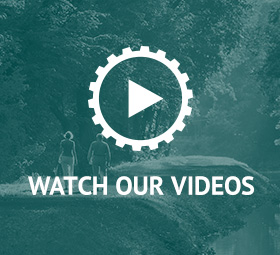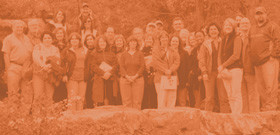The D&L Blog

In 1942, during a period of wartime rationing, a Pennsylvania hiker encouraged his walking companions by reminding them that “hiking is a matter of muscles, not rubber tires and gasoline, and so we need not forego the simplest and yet most glorious of sports.” This is a good reminder for twenty-first century Americans, surrounded as we are by chaotic markets, debates over oil, climate change, and sustainability, and high tech gadgetry. Walking and its various manifestations (hiking, jogging, even biking) require just two things: good old body power and a path. Thanks to subdivisions, busy roads, and privatization of the land, however, even this basic activity is increasingly difficult to pursue.
Trails in the Lehigh Valley
Given such circumstances, the organizations that are currently working to protect and maintain existing trails and attempting to expand walking, hiking, and biking opportunities are doing critical work. In the Lehigh Valley, we are blessed with several long-distance trails. The Delaware &Lehigh (D&L) Trail follows the Delaware and Lehigh Canals for 165 miles between Bristol, Bucks County and Wilkes-Barre, Luzerne County, making stops in Easton, Bethlehem, Allentown, and a number of other communities. The Appalachian Trail runs along the Kittatinny Ridge in Berks, Lehigh, and Northampton counties. The Palmer Bike Path, Slate Heritage Trail, Lehigh Parkway, Ironton Rail Trail, and an extensive park system provide ample opportunities for nature walks, biking, jogging, and the occasional commute.
A Pragmatic Justification of Trails
Most of us probably support the creation and protection of trails because they provide opportunities for recreation, simple transportation, and are aesthetically pleasing. Unfortunately, not everyone does. Many taxpayers would be upset to find that the state and federal governments allot tens of millions of dollars for trail construction and maintenance every year. They would argue that concern for open, green space and recreation should take low priority, during periods of economic instability. These are significant and widespread opinions that are difficult to counter.
Economic Impact
For all of the trail critics who oppose investment and all of the proponents that wish to make an argument on behalf of trails, there is a more pragmatic justification for investment in trails: economic impact. A number of recent studies have show that communities can improve their economic base by constructing trails or catering to existing trail users. There are two arguments to be made here. First, trail users spend significant amounts of money at state and local businesses. A 2006 study of the Pine Creek Rail Trail in Tioga and Lycoming Counties found that trail users spent an average of $350 on hard goods (bikes, clothing, etc.) related to their use of the trail each year. The average user also spent an additional $230 on accommodations and $30 per person on soft goods (food, drinks, souvenirs, etc.) on each trip to the trail. A similar study conducted in 2008 at sites along the D&L Trail found that 65% of trail users spent $50 or more on each trip. A 1999 University of Pittsburgh study found that six trailheads along the Allegheny Trail in western Pennsylvania each generated from $5.4 to $14.1 million each year. In short, trail users pump tens of millions of dollars into local and state economies every year, but they can only do so when communities have decided to invest in the construction and maintenance of those trails.
Community Impact
Second, communities with trails tend to have higher real estate values, less crime, and more vibrant downtowns. The National Association of Realtors has found that access to trails often ranks higher than security, parks, and sports fields in surveys of potential homebuyers. In a 2004 New York Times survey, 57% of potential homebuyers cited access to trails as an important feature of a new home. Indeed, homeowners with property adjacent to trails report 1% to 6% higher real estate values than the national average. Of course, increases in property values are only a monetary expression of what we already know: trails improve our quality of life. Home owners are willing to pay more for nearby recreational opportunities, a sense of community, and easy transportation. Unlike other forms of gentrification and redevelopment, the positive characteristics of trails also benefit the people already living and working in the community.
Investing in the Lehigh Valley’s Trail Infrastructure
The Lehigh Valley is unique for its blend of history, culture, and natural beauty, but the region’s towns have suffered from deindustrialization and suburbanization. Traditional main streets, like those in Freemansburg, Northampton, Slatington, Walnutport, and Palmerton, are no longer vibrant centers of business and social life. Ironically, town dwellers are more likely to drive to the countryside for shopping and entertainment than they are to walk to the center of their community. Trails cannot solve all of these problems, many of which result from macroeconomic and cultural trends beyond our control. But, if we support the construction of trails, we can at least give our downtowns the opportunity for a renaissance. Look at the success of Pocono Whitewater and Jim Thorpe in reinventing the Lehigh Gorge as a recreational biking, rafting, and hiking mecca.
We already have the infrastructure in place to do the same thing here. The towpath of the Lehigh Canal runs through almost every major town in the Lehigh Valley and connects to parkways and trails that provide access to communities off of the river. Imagine snack stands, bicycle repair shops, restaurants, and bed and breakfasts springing up in downtown Freemansburg, in an abandoned store front in Allentown, or on an old railroad property in Cementon. Imagine commuters traveling from Bethlehem Township to Easton on the Palmer Bike Path or from Egypt to Coplay on the Ironton Rail Trail. Devoted individuals and organizations have been working for decades to make these images a reality, but they need our support to convince policymakers to protect land and invest in trails. There are hundreds of national and local examples of how effective trails can be at rejuvenating economies and improving community life. We in the Lehigh Valley need to advocate the same for our communities and support the ongoing projects that are achieving success.










